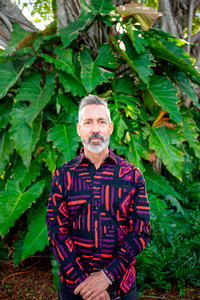Given Miami’s tropical climate and close proximity to the beach, the University of Miami’s course listing would not be complete without “Hawai’i and the Pacific World: Or, How Surfing Colonized California and the World,” a class offered during the Spring 2025 semester by the College of Arts and Sciences’ Department of History.
Martin Nesvig, a professor and the director of undergraduate studies for the Department of History, created the course and looks forward to teaching it again. “It's the most popular class of all the classes that I’ve taught at the U during the last 20 years,” he stated.
In this interview, Nesvig discusses the attributes of the course that have led to its success.

1. Why were you interested in teaching this course?
I was born and raised in San Diego, California, and now that I live in Miami, I’ve spent a lot of time in my life in the ocean. I developed a course here on the history of beaches, which included a section on Hawai’i. Students loved this part of the class and always encouraged me to create an entire class dedicated to Hawai’i. The history of Hawai’i and surfing are so intertwined that you cannot separate them. So, although I am a Latin Americanist by training and I have surfed before (but do not consider myself a surfer), I taught myself about the history of Hawai’i and surfing and I can now say I know about the subject.
2. What are students’ favorite aspects of the course?
Every class, we watch a surf video. However, it’s not just, ‘Bro, we’re going to sit back and watch surfers’. We analyze specific breaks from an oceanographic science lens as well as a Hawai’ian mythological lens. Usually, there are a few surfers in the course, and they enjoy contributing to discussion on the videos. Overall, the students tend to get very into the videos.
3. The course description mentions music. How do you incorporate information about surf music into the course?
In all of my classes, I like to play music as I set up because it is a concrete experience. Regarding Hawai’i, we listen to traditional Hawai’ian music, which is mostly percussive instruments and chants. Towards the end of the course, we discuss surfers’ feelings towards Californian surf punk rock music groups. They tend to like surf music; however, they oftentimes specifically viewed the group The Beach Boys as posers.
4. Do you speak about Hawai’ian food in the course?
Hawai’ians are very complex in their food culture, so we cover it. Historically, they were very egalitarian regarding sexuality, but it was considered taboo for men and women to eat together. Women were not allowed to eat pork—although this was a large part of the diet—or bananas. However, Hawai’ians were very open sexually, and culturally were what people would refer to as polyamorous today.
5. Is surf language discussed in the course?
There is a lot of different language associated with surfing. Some of it comes from Hawai’i, and some of it comes from California. Kook, grom, kona, goofy foot, etc.
6. For students who have never taken a history course and want to take this class as an elective, what would you advise them to do to be successful?
There is no secret formula. Come to class and pay attention. It is a history course, so there will be reading and assignments, but students tend to enjoy the class regardless of the workload.
The preview of topic areas shared by Nesvig provides a glimpse into the complexities of Hawai’ian history and surfing culture, which are further explored in his course. The course is open to students of all academic backgrounds and can count for credit towards an individualized arts and humanities cognate or an individualized people and society cognate. The last day for students to add a course to their schedule is January 22, 2025.

